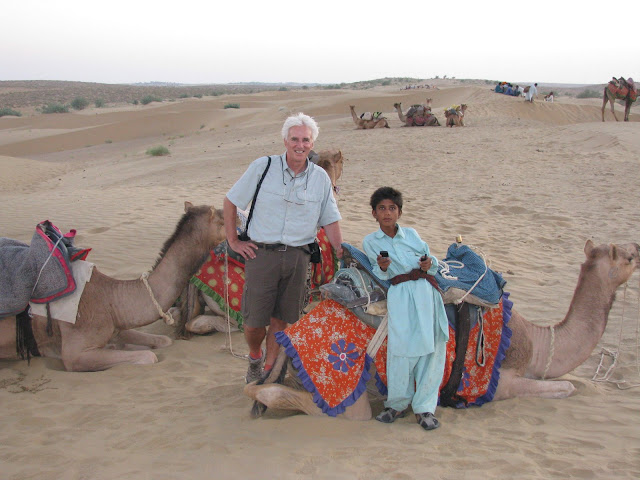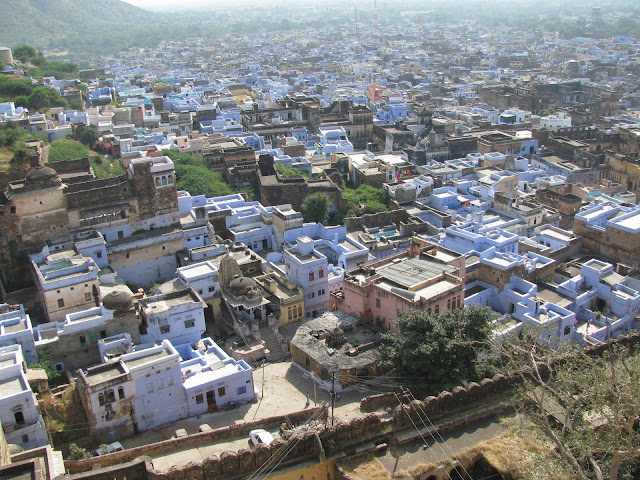After the heat and dust of the deserts of Rajasthan we move north to Amritsar, home to Sikhism's holiest shrine since the 16th century, the glorious Golden Temple. Tim takes in the deeply spiritual temple as the sun reflects on the holy waters (yes, he realizes his temple head covering isn't his best look).
Every late afternoon, just before sunset, the Indian and Pakistani military meet at the border to engage in an extraordinary 20-minute ceremony of pure theatre. The border-closing ceremony elicits machismo and posturing from the proud young soldiers on both sides, but also, despite the two countries uneasy relationship, a stunning display of harmony. Preceded by a kick so high the soldier looks in danger of concussing himself, the high-octane march to the border is vaguely reminiscent of Monty Python's Ministry of Silly Walks sketch.
We leave Amritsar for a day-long drive to the British hill station, Dharmasala, the home of the Dali Lama and the base for his government in exile from Tibet. The location, close to the foothills of the Himalayas at 1800 meters, mimics Tibet to some degree. Sandi dons four layers as the temperature drops to 12 centigrade. We tour the Tibetan Museum to gain insight into the suffering of Tibetan people under Chinese domination. Our accommodation, Chonor Guest House, has rooms themed after aspects of Tibetan culture. The walls are covered from floor to ceiling with murals painted by local Tibetan artists as in the photo above taken in our room.
On to Shimla, the preferred summer mountain escape (2150 m) of the British Raj. It was here that the British ruled India for six months of the year for 50 years until India was granted Independence in 1947. We toured the mansion formerly known as Viceregal Lodge, built in 1888 at the request of the first British Viceroy. It remains an architectural testament to the power of the British Raj.
Aboard the romantic toy train, the Himalayan Queen, which chugs it way to Kalka at an average sleepy speed of 17 mph along spectacular ridges offering incredible views of the surrounding countryside. It travels through 100 tunnels, numerous bridges and sharp curves taking in picturesque views of green forests and meadows, distant snow covered mountains and red-roofed homes. In 2008 it was designated Unesco World Heritage status.
Back along the Ganges River in Rishikesh (a town close to the source of the Ganges) with its collection of sadhus, hippies and backpackers all seeking spiritual enlightenment. Rishikesh was made famous by the Beatles and the Maharishi Mahesh yogi in the 60s. It is here that they found inspiration for their Sergeant Pepper's album. The town is a spiritual Disneyland of concrete ashrams bedecked with gaudy statues of the hindu gods Vishnu and Shiva as in the photo below.
We search out the Maharishi's ashram where the Beatles chilled out. Since the Maharishi's death in 2007, the property now lies derelict due to legal battles for his 6 million dollar fortune.
Along the sides of India's backroads are large piles of neat "mud pies" that Sandi thought looked like big chocolate chip cookies but our driver explained they are a combination of cow dung and straw used for fuel to cook and heat homes in winter. Holy (cow) shit! Sandi bolts to find a loo to wash her hands after this photo was taken.
After northern India we stop briefly in Delhi to catch a flight to Mumbai (back to the warmth!) where Tim lashes out for an expensive hotel, the Marine Plaza, Mumbai's third best hotel after the Taj Palace and Oberoi group. Among the main sights we tour are the beautiful Victoria Terminus train station (photo below), the Taj Palace Hotel (seen on the left in the photo above) and lunch at Leopolds Café, all locations where 24 hours later Pakistani terrorists indiscriminately open fire on Indian and foreign tourists killing 125 to date. It is being described as India's worst terrorist attack. Luckily we took a flight to Aurangabad the day before and were safe from the horror. We feel incredibly blessed to have avoided this tragedy and our hearts and prayers go out to the people of Mumbai and India.
From Aurangabad we hire a driver to take us to the ancient cave temples of Ellora which are rated amongst the finest historical sites to be found anywhere in India. The 34 rock sculpted temples, created between the 4th and 9th centuries, were literally chiseled out of the hillside by Buddhists, Hindus and Jains with simple hand tools. The highlight is Cave 16 (two photos below), a dazzling visualization of Mt. Kailash, the mythical abode of the god Shiva in the Tibetan Himalayas. It took 150 years to create and was worked on by more than 800 local artisans. We are speechless.
During the 2nd century BC a long curving swathe of rock was chosen above a river bed as a site for one of the most important chapters in the creative history of Buddhism. For the next 700 years Buddhist monks dedicated their life to carving out prayer halls and monasteries using little more than hand-made tools. The caves are ornately decorated with magnificent sculptures and murals depicting the life and times of Buddha and were mysteriously abandoned in the 9th century and discovered by chance by a British hunting party in 1819. The site is arguably the best preserved Buddhist site in India.
Don't try this at home.
This chap has had a little too much paneer (high cal Indian cheese dish).
Finely detailed tempera paintings once covered entire surfaces of some of the temples—now only fragments remain such as this close-up of a charming scene of a thousand buddhas.
Born to be wi-i-i-i-ld. Tim can't resist a spin on our driver's brother's motorbike on the way back from the caves. Tonight (28 Nov) we fly from Aurangabad to Mumbai for an overnighter then on to Panaji, Goa for 15 days of R & R on some of India's finest beaches.
















































